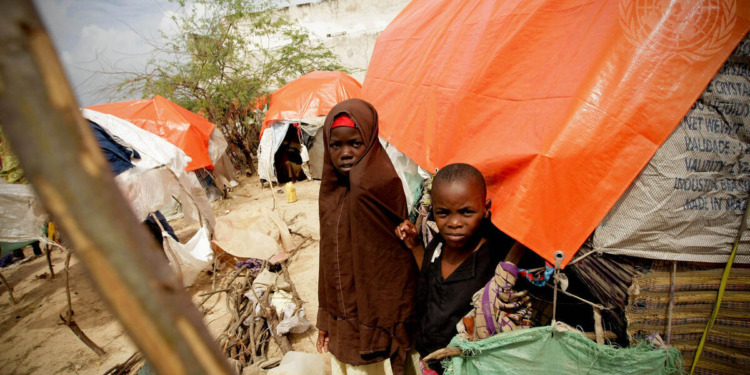Four consecutive years of insufficient and unprecedentedly low rainfall have brought on the worst drought the Horn of Africa has seen in 40 years; this historic drought has now almost doubled the number of people in the region facing starvation compared to the beginning of this year and has forced over a million people to flee their homes looking for food and water, according the United Nations’ World Food Programme (WFP).
No rain & diminishing resources are pushing millions of families across the Horn of Africa closer to catastrophe every day as the driest conditions in 4 decades continue.@WFP explains what is needed to scale-up assistance & save lives:https://t.co/O8OIsvFv01
— United Nations (@UN) April 19, 2022
Particularly affected are Kenya, Ethiopia and (the worst affected) Somalia, where every second person is acutely food insecure. BBC Africa journalist Mercy Juma writes that “[m]others are burying their children; families are separating as fathers head to towns to eke a living and mothers and children move to camps to wait for aid.”
The camps, however, are overcrowded and struggle to meet the overwhelming needs. The drought has meanwhile also killed millions of livestock and destroyed significant amounts of crops.
Related Article: World Facing Unprecedented Hunger Crisis: “Famine Around the Corner” in Horn of Africa | Global Food Crisis Becomes Strategic Pivot in Russo-Ukrainian War
At the start of 2022, 13 million people in the Horn of Africa were at risk of starvation as a result of the drought. As the rain then failed to appear again and the drought continued, this number climbed to 20 million people by mid-2022, according to WFP estimates.
By September, WFP says that at least 22 million people in Ethiopia, Somalia and Kenya will be struggling to feed themselves.
🆘#HornofAfrica Drought🆘
2️⃣2️⃣ million: The number of people projected to face extreme hunger in parts of Somalia, Ethiopia and Kenya due to drought.
At the start of the year, we warned that 13 million people were at risk…
Support is urgent.
— World Food Programme (@WFP) August 19, 2022
“There are now four seasons where the rain didn’t come as predicted and a fifth season is estimated to also fail. In places where there is drought, the problem keeps worsening and worsening,” WHO Incident Manager Sophie Maes said.
Not just the drought
As the World Health Organization (WHO) emphasized on July 30 in their emergency response appeal for the Greater Horn of Africa, the drought and its consequences were exacerbated by climate change, conflict, rising food and energy prices, and the COVID-19 pandemic.
The Russian invasion of Ukraine of course played a major role here as it drew attention away from humanitarian disasters elsewhere, including in East Africa, and caused spikes in global food and fuel prices that particularly affected the world’s most vulnerable regions like the Horn of Africa and made delivery of humanitarian aid more expensive, difficult and slow.
Regrettably, with a fifth consecutive failed rainy season in the Horn of Africa forecasted later this year, the situation is only expected to get worse.
Climate change is creating bitter new realities globally. The Horn of Africa is bearing the biggest brunt. For the first time since records began, there's a chance that a fifth rain season will fail in much of the area. It's immoral & unethical that we keep quiet about this. A 🧵 pic.twitter.com/7xS2j1iNQP
— Mercy Juma (@MercyJuma_) July 19, 2022
“This number [of people facing starvation in the Horn of Africa] will continue to climb, and the severity of hunger will deepen if the next rainy season … fails and the most vulnerable people do not receive humanitarian relief,” WFP wrote.
According to their estimates, $418 million will be needed to help the most vulnerable over the upcoming half a year.
“The world needs to act now to protect the most vulnerable communities from the threat of widespread famine in the Horn of Africa,” WFP Chief David Beasley said last week. “There is still no end in sight to this drought crisis, so we must get the resources needed to save lives and stop people plunging into catastrophic levels of hunger and starvation.”
Editor’s Note: The opinions expressed here by the authors are their own, not those of Impakter.com — In the Featured Photo: Somali children stand at a camp for Internally Displaced Persons (IDPs) in Mogadishu. Somalia is affected by a severe drought that has ravaged large swaths of the Horn of Africa, leaving an estimated 22 million people in need of humanitarian assistance. Featured Photo Credit: United Nations.










